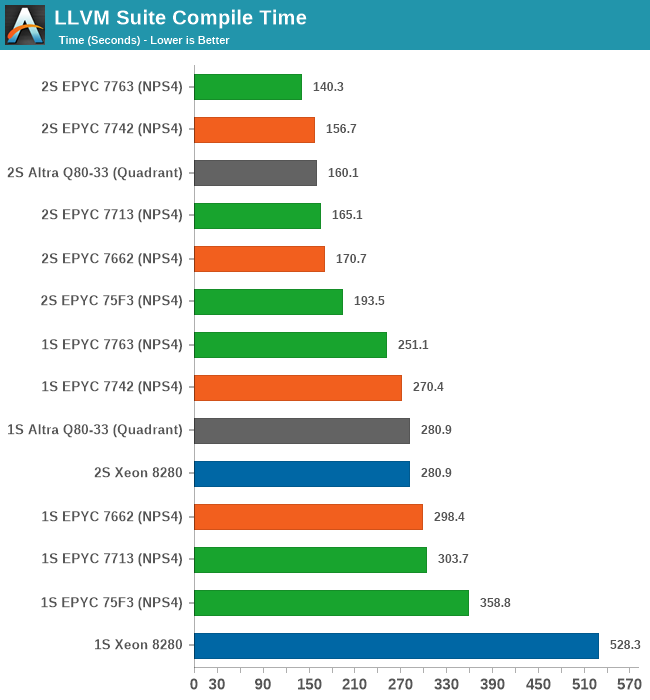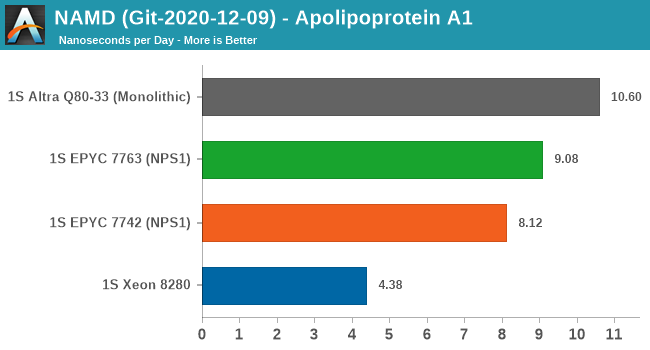AMD 3rd Gen EPYC Milan Review: A Peak vs Per Core Performance Balance
by Dr. Ian Cutress & Andrei Frumusanu on March 15, 2021 11:00 AM ESTDisclaimer June 25th: The benchmark figures in this review have been superseded by our second follow-up Milan review article, where we observe improved performance figures on a production platform compared to AMD’s reference system in this piece.
Compiling LLVM, NAMD Performance
As we’re trying to rebuild our server test suite piece by piece – and there’s still a lot of work go ahead to get a good representative “real world” set of workloads, one more highly desired benchmark amongst readers was a more realistic compilation suite. Chrome and LLVM codebases being the most requested, I landed on LLVM as it’s fairly easy to set up and straightforward.
git clone https://github.com/llvm/llvm-project.gitcd llvm-projectgit checkout release/11.xmkdir ./buildcd ..mkdir llvm-project-tmpfssudo mount -t tmpfs -o size=10G,mode=1777 tmpfs ./llvm-project-tmpfscp -r llvm-project/* llvm-project-tmpfscd ./llvm-project-tmpfs/buildcmake -G Ninja \ -DLLVM_ENABLE_PROJECTS="clang;libcxx;libcxxabi;lldb;compiler-rt;lld" \ -DCMAKE_BUILD_TYPE=Release ../llvmtime cmake --build .We’re using the LLVM 11.0.0 release as the build target version, and we’re compiling Clang, libc++abi, LLDB, Compiler-RT and LLD using GCC 10.2 (self-compiled). To avoid any concerns about I/O we’re building things on a ramdisk. We’re measuring the actual build time and don’t include the configuration phase as usually in the real world that doesn’t happen repeatedly.

For the new Milan chips, the results are a bit mixed. The higher-power 7763 takes a lead with a +10.5% improvement over the 7742, however the 7713 doesn’t manage to keep up with that predecessor.
The 1S vs 2S scores are interesting as the 2S figures showcase the new Milan chips in a better light due to the higher single-threaded performance of the Zen3 cores. The compilation here also has linking phases which are single-thread performance bottle-necked. This results in scenarios such as the 7713 losing to the 7662 in 1S comparisons, however winning out against the same chip in the 2S comparison, as it’s able to make that advantage count for more.
It’s also great to see the 75F3 keep up with the 64-core counterparts at around 72% of the top-SKU performance.

Finally, in NAMD, this is more of a core-local compute workload. We see the 7763 outperform the 7742 by +11.8%, however the Milan chip is still outperformed by the higher core compute capacity of the 80-core Altra chip.
Generally, I have my reservations about NAMD as a benchmark due to its multicore vs MPI variants and scaling anomalies, on top of the whole topic of the benchmark having a completely different algorithm for AVX512 processors.










120 Comments
View All Comments
gustavowoltmann - Saturday, March 27, 2021 - link
https://www.anandtech.com/Calin - Tuesday, March 16, 2021 - link
That's "team Anandtech" but from the times when the site was done by a single person.I used to read Tom's Hardware, then it and Anandtech (sometime before 2000 I think, the site was started in 1997), then Anandtech only.
Lots of quality hardware information, even though at first the site sometime covered antiviruses and some other software.
Considering the entire history, reviewers other than Anand are a recent phenomenon :)
MenhirMike - Monday, March 15, 2021 - link
I wonder if AMD is going to add 120 W CPUs again - EPYC Rome had 4 CPUs with only 4 memory channels of bandwidth, but with a lower TDP, including the EPYC 7282.zanon - Monday, March 15, 2021 - link
They do have an EPYC Embedded (3000 series) line that's still Zen 1. Maybe they'll move that to Zen 3 and that's where the low TDP stuff will go?Foeketijn - Monday, March 15, 2021 - link
Yes, it's a shame those type of parts didn't really get attention yet. It's really great you can get 128 Cores and 256 threads in a 2U server, But if you just need 20 VM's running on a super stable platform, 16 threads and 50 Watts are more than enough.Spunjji - Friday, March 19, 2021 - link
I believe they're leaving that segment to Romepowerarmour - Monday, March 15, 2021 - link
ARM is going to be the tech to watch in this space IMHO, especially with NVIDIA's upcoming weight behind it.TheinsanegamerN - Monday, March 15, 2021 - link
2014 called and wants its prediction back.powerarmour - Monday, March 15, 2021 - link
Ampere Altra responded to the call, but is currently engaged.MenhirMike - Monday, March 15, 2021 - link
It's not as egregious as "Linux on the Desktop": ARM on the server is actually gaining foothold, especially for Cloud-hosted companies.Though x86-64 will be around for a LONG time - ARM might (and likely will) get a nice Marketshare, but it will not seriously threaten x86-64 for decades, if ever.
One thing that ARM is sorely lacking are some workstations to test stuff on. The Ampere eMag was based on ancient hardware, Raspberry Pi isn't specced nearly the same, and I'm not putting an Ampere Altra on my desk.